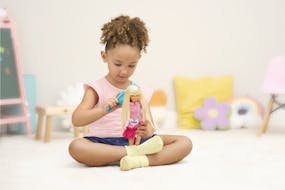How often should my baby be pooing?
Advertisement Promotion
How often (or not) your baby goes for a poo – and what it looks like – is something our Netmums members talk about A LOT in our forum. Which is no surprise given you could be changing your baby’s nappy up to 12 times a day.
Before you became a mum, the colour and consistency of your baby’s poo is probably not something you thought you’d be obsessed with.
But your baby’s bowel movements can give you a real insight into her general health, digestion, and even whether she’s getting enough milk.
All of which means it’s important you get to know your baby’s bowel habits – from the newborn meconium through to the solid poos your baby will have after weaning.
FREE NEWBORN NAPPIES
To help, we’ve got all you need to know about your baby’s bowel movements, including what’s normal and what might be making her poo a different colour or consistency.
We also answer the question every mum of a baby under one wants to know ... ‘How often should my baby be pooing?’
8 types of baby poo and what they mean
Here are eight of the most common types of poo you’ll find in your baby’s nappy:
1.
Newborn poo
For the first couple of days after she’s born, your baby’s poo will be greenish-black and quite sticky – a bit like tar. It won’t smell, but can be hard to wipe off her skin.
Why? This is called meconium and is made up of anything your baby ingested in the womb, including amniotic fluid and mucus.
What you can do … Try dabbing some petroleum jelly onto your baby’s bottom before her first nappy change to make it easier to wipe away the meconium.
2. Mustard yellow poo
If you’re breastfeeding your baby, her poo will be quite yellow and smell sweet. It’s also likely to be grainy (it might look like it has seeds in it) and be quite loose.
In the early weeks, your baby might poo after every feed. However, by the time she’s six-weeks-old, your baby might only poo every few days.
Why? Your baby’s stomach bile makes her poo a yellow colour, a bit like Dijon mustard.
What you can do … Eat a healthy diet if you’re breastfeeding so your baby is getting all the nutrients and vitamins she needs.
3.
‘Peanut butter’ poo
If your baby is having formula. it’s likely her poos will be yellowy-brown and look a bit like peanut butter. They might also be a bit smelly. As a newborn, she might poo up to five times a day.
Why? The different colour and texture of a formula-fed baby’s poo is because formula isn't digested as fully as breast milk.
What you can do … This is totally normal, so you don’t need to do anything. However, if you’re worried your baby is constipated – if her poos look like hard pellets or she's struggling to pass them – talk to your health visitor or GP.
4.
Green poo
It can be quite a surprise to change your baby’s nappy and find a green poo inside. But there is a reason for it ...
Why? In the early days, it can be very normal to find greenish poo in your baby's nappy.
But, if you're breastfeeding, a bright green poo can be a sign she’s not getting the rich hind milk at the end of the feed.
And if you’re weaning your baby, it might simply be down to the spinach puree she had for lunch, which is normal.
What you can do … Try leaving your baby on the breast for longer, or start each feed on the breast you ended on last time. For more advice, contact your health visitor or a breastfeeding counsellor.
5. Your baby doesn’t poo very often
When your baby is a few weeks old, she might not have a poo for several days.
Why? As your baby gets older, she's absorbing more of the nutrients in your breast milk. And this means there's less ‘waste’ for her body to get rid of.
What you can do … If your baby’s poos are soft when she does go, and she’s not struggling to poo, then there’s no need to do anything.
If the poo's hard and looks like pellets, your baby could be constipated. Contact your health visitor or GP for more advice.
6.
Bright orange poo
You’ve started weaning your baby and suddenly her poo is bright orange. But don’t panic …
Why? If your baby eats pureed carrot, her next poo is likely to be orange. And if she eats beetroot, her poo could well have a reddish tinge.
What you can do ... You don’t need to do anything. It’s a sign her digestion is working well.
7.
Undigested food in your baby’s poo
Your baby's now on solids, which can affect the colour of her poo. But it can also mean that occasionally when you change her nappy, you’re greeted by a bit of undigested carrot or a sweetcorn kernel.
Why? Foods that are rich in fibre are likely to pass straight through your baby without being digested.
What you can do … If this is happening a lot, talk to your GP to check your baby's absorbing food properly.
8.
Diarrhoea
It’s not unusual for babies to get diarrhoea. Signs include much runnier poo than normal and ‘explosive’ poos.
Why? Diarrhoea could be a sign your baby has an infection or allergy, or her digestive system simply didn't agree with something she ate.
What you can do … Diarrhoea can make your baby dehydrated, so it’s important to watch out for warning signs including sunken eyes or fewer wet nappies. Make sure your baby is drinking cooled boiled water between feeds (if bottle-fed) or feeding regularly (if breastfed).
If you’re concerned, call 111 or talk to your GP.
Nappy essentials
With so many nappy changes, it’s important to have all the essentials you need to gently clean and protect your baby’s bottom … and make sure those poos don’t leak out!
Our nappy essentials are:
- Barrier cream – this helps prevent nappy rash. Apply a thin layer during each nappy change.
- Properly fitting nappies – your baby’s nappy should fit snugly around her waist, legs and bottom. If they start leaking, it’s probably time to go up a size.
- Baby wipes – don’t leave home without them! Baby wipes are ideal for gently cleaning your baby’s bottom.
- Nappy sacks – a great way to get rid of your baby’s dirty nappies. Try fragranced ones that will even neutralise the smell. To avoid suffocation risks, remember to always keep them out of your baby's reach.
- Changing mat – it’s a good idea to have a changing mat for home and a travel changing mat for when you’re out.




